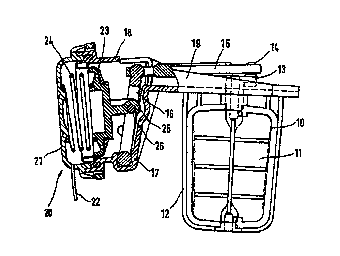Some of the information on this Web page has been provided by external sources. The Government of Canada is not responsible for the accuracy, reliability or currency of the information supplied by external sources. Users wishing to rely upon this information should consult directly with the source of the information. Content provided by external sources is not subject to official languages, privacy and accessibility requirements.
Any discrepancies in the text and image of the Claims and Abstract are due to differing posting times. Text of the Claims and Abstract are posted:
| (12) Patent Application: | (11) CA 2297227 |
|---|---|
| (54) English Title: | DEVICE FOR MOVING A VALVE FLAP |
| (54) French Title: | DISPOSITIF POUR DEPLACER UN CLAPET DE SOUPAPE |
| Status: | Deemed Abandoned and Beyond the Period of Reinstatement - Pending Response to Notice of Disregarded Communication |
| (51) International Patent Classification (IPC): |
|
|---|---|
| (72) Inventors : |
|
| (73) Owners : |
|
| (71) Applicants : |
|
| (74) Agent: | NORTON ROSE FULBRIGHT CANADA LLP/S.E.N.C.R.L., S.R.L. |
| (74) Associate agent: | |
| (45) Issued: | |
| (86) PCT Filing Date: | 1998-06-24 |
| (87) Open to Public Inspection: | 1999-01-21 |
| Availability of licence: | N/A |
| Dedicated to the Public: | N/A |
| (25) Language of filing: | English |
| Patent Cooperation Treaty (PCT): | Yes |
|---|---|
| (86) PCT Filing Number: | PCT/EP1998/003868 |
| (87) International Publication Number: | EP1998003868 |
| (85) National Entry: | 2000-01-11 |
| (30) Application Priority Data: | ||||||
|---|---|---|---|---|---|---|
|
The invention relates to a device for moving a valve flap, especially in the
intake system of an internal combustion engine. The inventive device consists
of a vacuum cell (20) which performs a lengthways movement in dependence on
the application of a negative pressure. Said lengthways movement is
transmitted to a cross-member (15) via a coupling rod (16). Said cross-member
(15) is connected to a lever of the valve flap (11). The coupling rod and
cross-member system allows the vacuum cell to be arranged in any position in
relation to the valve flap (11). The invention can be simplified further by
amalgamating the diaphragm disk (27) with the cross-member (15) so that they
form a single integral part. In this case, a force is exerted excentrically on
the vacuum cell. Said force can be compensated by the diaphragm having a shape
other than a round contour.
L'invention concerne un dispositif pour déplacer un clapet de soupape, notamment dans le système d'admission d'un moteur à combustion interne. Ce dispositif comprend un boîtier à dépression (20) qui exécute un mouvement longitudinal en fonction d'une dépression à laquelle il est soumis. Ce mouvement longitudinal est transmis par l'intermédiaire d'une tige d'accouplement (16) à une traverse (15) reliée à un levier du clapet de soupape (11). L'ensemble tige d'accouplement et traverse permet de placer le boîtier à dépression dans n'importe quelle position, par rapport au clapet de soupape (11). On peut également simplifier le dispositif en associant la plaque membranaire (27) et la traverse (15) pour former un élément constitutif monobloc. Il en résulte alors, au niveau du boîtier à dépression (20), une force s'exerçant de façon excentrée, que l'on peut compenser en concevant la membrane de façon à ce qu'elle ne présente pas un contour rond.
Note: Claims are shown in the official language in which they were submitted.
Note: Descriptions are shown in the official language in which they were submitted.

2024-08-01:As part of the Next Generation Patents (NGP) transition, the Canadian Patents Database (CPD) now contains a more detailed Event History, which replicates the Event Log of our new back-office solution.
Please note that "Inactive:" events refers to events no longer in use in our new back-office solution.
For a clearer understanding of the status of the application/patent presented on this page, the site Disclaimer , as well as the definitions for Patent , Event History , Maintenance Fee and Payment History should be consulted.
| Description | Date |
|---|---|
| Application Not Reinstated by Deadline | 2003-06-25 |
| Time Limit for Reversal Expired | 2003-06-25 |
| Deemed Abandoned - Failure to Respond to Maintenance Fee Notice | 2002-06-25 |
| Letter Sent | 2000-05-17 |
| Inactive: Single transfer | 2000-04-20 |
| Inactive: Cover page published | 2000-03-21 |
| Inactive: First IPC assigned | 2000-03-17 |
| Inactive: Courtesy letter - Evidence | 2000-03-07 |
| Inactive: Notice - National entry - No RFE | 2000-03-02 |
| Inactive: Inventor deleted | 2000-03-02 |
| Application Received - PCT | 2000-02-28 |
| Application Published (Open to Public Inspection) | 1999-01-21 |
| Abandonment Date | Reason | Reinstatement Date |
|---|---|---|
| 2002-06-25 |
The last payment was received on 2001-05-17
Note : If the full payment has not been received on or before the date indicated, a further fee may be required which may be one of the following
Patent fees are adjusted on the 1st of January every year. The amounts above are the current amounts if received by December 31 of the current year.
Please refer to the CIPO
Patent Fees
web page to see all current fee amounts.
| Fee Type | Anniversary Year | Due Date | Paid Date |
|---|---|---|---|
| Basic national fee - standard | 2000-01-11 | ||
| Registration of a document | 2000-04-20 | ||
| MF (application, 2nd anniv.) - standard | 02 | 2000-06-27 | 2000-06-14 |
| MF (application, 3rd anniv.) - standard | 03 | 2001-06-25 | 2001-05-17 |
Note: Records showing the ownership history in alphabetical order.
| Current Owners on Record |
|---|
| FILTERWERK MANN & HUMMEL GMBH |
| Past Owners on Record |
|---|
| ARTHUR KLOTZ |
| GEORG MEHNE |
| THOMAS JESSBERGER |